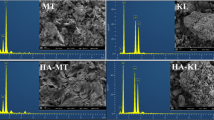Abstract
The bound water in soil directly controls the special physical, chemical, and mechanical properties of clay. This paper carries out isothermal adsorption tests on a series of artificially mixed clays and explores the relationship between bound water content and clay mineral composition (montmorillonite content). On this basis, three common empirical models of adsorption were adopted to fit the isothermal adsorption data separately, and their applicability to bound water adsorption by clay was evaluated in turn. The results show that by the isothermal adsorption method, the relatively humidity (RH) of 0.9 is the boundary between strong and weak bound waters, and the RH of 0.98 is the boundary between weak bound water and free water; For the mixed clays with the same mineral composition, the bound water content linearly increases with the growing content of montmorillonite; GAB model works excellently at RH = 0 ~ 100%, with a good fitting effect (R2>0.90); the parameters of GAB model have clear physical meanings, and change in line with the trend of the hydration process of bound water adsorption by clay. Therefore, GAB model is the most suitable model for fitting the isothermal adsorption data on bound water of clay.










Similar content being viewed by others
Change history
28 September 2021
An Editorial Expression of Concern to this paper has been published: https://doi.org/10.1007/s12517-021-08472-7
References
Akin ID, Likos WJ (2014) Specific surface area of clay using water vapor and EGME sorption methods. Geotech Test J 37(6):1016–1027
Brunauer S, Emmett PH, Teller E (1938) Adsorption of gases in multimolecular layers. J Am Chem Soc 60(2):309–319
Dontsova KM, Norton LD, Johnston CT, Bigham JM (2004) Influence of exchangeable cations on water adsorption by soil clays. Soil Sci Soc Am J 68(4):1218–1227
Hatch CD, Wiese JS, Crane CC, Harris KJ, Kloss HG, Baltrusaitis J (2012) Water adsorption on clay minerals as a function of relative humidity: application of BET and Freundlich adsorption models. Langmuir 28(3):1790–1803
Herzog RO (2015) Kapillarchemie, eine Darstellung der Chemie der Kolloide und verwandter Gebiete. Von Dr. Herbert Freundlich. Verlag der Akademischen Verlagsgesellschaft. Leipzig 1909. 591 Seiten. Preis 16,30 Mk. geb. 17,50 Mk. Zeitschrift Für Elektrochemie Berichte Der Bunsengesellschaft Für Physikalische Chemie 15(23):948–948
Langmuir I (1918) The adsorption of gases on plane surfaces of glass, mica and platinum. J Am Chem Soc 40(9):1361–1403
Li SL, Bo ZZ, Qin SJ, Zhang ZY (1982) Translation anthology of absorbed water in soils. Geological Publishing House, China, Beijing
Li YL, Wang TH, Su LJ (2015) Determination of bound water content of loess soils by isothermal adsorption and thermogravimetric analysis. Soil Sci 180(3):90–96
Li S, Wang C, Zhang X, Zou L, Dai Z (2019) Classification and characterization of bound water in marine mucky silty clay. J Soils Sediments 19(5):2509–2519
Martin RT (1962) Adsorbed water on clay: a review. Clay Clay Miner:28–70
Mitchell JK, Soga K (2005) Fundamentals of soil behavior, vol 3. John Wiley & Sons, New York
Neuhaus D (2013) Water adsorption and desorption pretreatment of surfaces increases the maximum amount of adsorbed water molecules by a multiple. Adsorption 19(6):1127–1135
Osipov VI (2012) Nanofilms of adsorbed water in clay: mechanism of formation and properties. Water Res 39(7):709–721
Song YP (2018) Influence of bound water on physical and mechanical properties of loess. Xi’an: Chang’an University, China
Tang SH (2017) Research on bound water and its influence on thermal conductivity of red clay. Guilin University of Technology, China
Timmermann EO (2003) Multilayer sorption parameters: BET or GAB values? Colloids Surf A Physicochem Eng Asp 220(1–3):235–260
Wang P (2005) Determination of bound water boundary on clay surface by isothermal adsorption. Journal of Southwest Petroleum University (Science & Technology Edition) 27(6):57
Wang TX, Li YL, Su LJ (2014) Types and boundaries of bound water on loess particle surface. Chinese Journal of Geotechnical Engineering 36(5):942–948
Wang H, Qian H, Gao Y, Li Y (2020) Classification and physical characteristics of bound water in loess and its main clay minerals. Eng Geol 265:105394
Wu Q (2015) Research on influence of bond water on secondary consolidation and long term strength of soft clay. Jilin University, China, Changchun
Wu YD (2019) Research on influence of water content on physical -mechanical properties of red clay and its micro-mechanism. Guilin University of Technology, China
Xu YS, Sun DA, Zeng ZT et al (2019) Temperature dependence of apparent thermal conductivity of compacted bentonites as buffer material for high-level radioactive waste repository. Appl Clay Sci 174:10–14
Yun WY (2016) Testing study on absorbed water in expansive and shrinkable soil. Guilin University of Technology, China
Zhang ZH (2018) Research on suction of unsaturated loess-bonded water. Xi’an: Chang’an University, China
Zhao CG, Bai B (2009) Fundamentals of soil mechanics. Tsinghua University Press, China
Acknowledgments
This research was supported by the National Natural Science Foundation of China [Grant No. 41962014, 52068016], the Natural Science Foundation of Guangxi Province, China [Grant No. 2018GXNSFAA138182], and the opening fund from Guangxi Key Laboratory of New Energy and Building Energy Saving [Grant No. 19-J-21-21, No. 16-J-21-6].
Author information
Authors and Affiliations
Corresponding author
Ethics declarations
Conflict of interest
The authors declare that they have no conflict of interest.
Additional information
Responsible Editor: Ahmed Farouk
This article is part of the Topical Collection on Big Data and Intelligent Computing Techniques in Geosciences
Rights and permissions
About this article
Cite this article
Xie, Y., Zeng, Z., Zhang, B. et al. Analysis and modeling of bound water adsorption by mixed clay based on adsorption theory. Arab J Geosci 14, 1089 (2021). https://doi.org/10.1007/s12517-021-07430-7
Received:
Accepted:
Published:
DOI: https://doi.org/10.1007/s12517-021-07430-7




